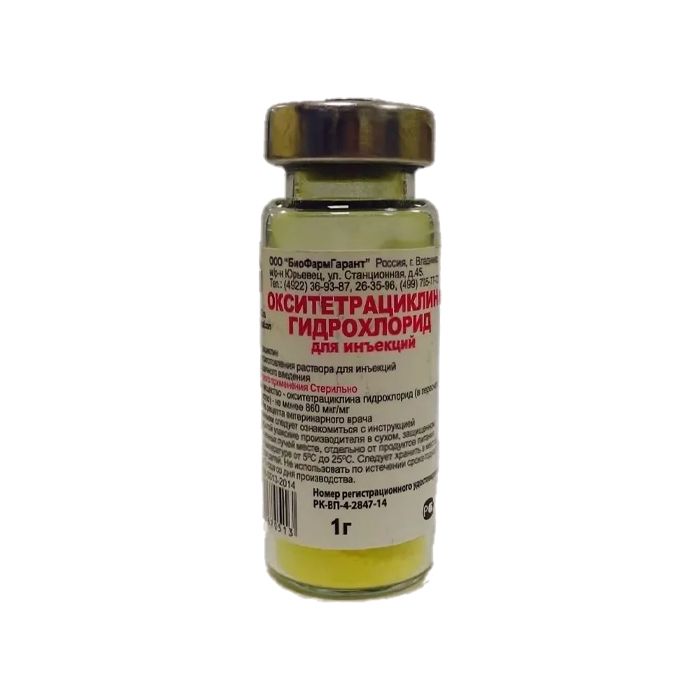Oxytetracycline hydrochloride 1g
DESCRIPTION
Oxytetracycline hydrochloride for injection belongs to the pharmaceutical group of antibacterial drugs.
COMPOSITION
Oxytetracycline hydrochloride for injection contains at least 860 Ојg / mg of oxytetracycline hydrochloride as an active ingredient (in terms of dry matter).
PHARMACOLOGICAL PROPERTIES
Oxytetracycline is a tetracycline antibiotic produced by Streptomyces rimosus. It has a broad spectrum of antibacterial action, is active against many gram-positive and gram-negative microorganisms, incl. Escherichia, Salmonella, Staphylococcus, Streptococcus, Rickettsia and some types of Mycoplasma; does not act on Pseudomonas aeruginosa, Proteus, most fungi and small viruses.
The mechanism of the antibacterial action of oxytetracycline hydrochloride is based on the suppression of protein synthesis of the microbial cell (blockade of the ribosome function) and blockade of RNA synthesis.
After intramuscular administration, oxytetracycline hydrochloride is rapidly absorbed into the bloodstream and penetrates into organs and tissues. The maximum concentration of the antibiotic in the blood is reached 30 minutes after administration and is maintained at a therapeutic level for 10 -12 hours. The antibiotic is excreted from the body mainly in the urine.
APPLICATION
Oxytetracycline hydrochloride for injection is used to treat respiratory bacterial infections, colibacillosis, salmonellosis, pasteurellosis, gastroenterocolitis in young farm animals, as well as mastitis, gynecological and other diseases of farm animals, the pathogens of which are sensitive to tetracyclines.
Before use, the drug is dissolved in 5-10 ml of water for injection, or sterile isotonic sodium chloride solution, or 1-2% sterile novocaine solution.
The resulting solution is injected intramuscularly with an interval of 10-12 hours for 5-7 days in the following doses (according to DV):
Animal type and age Dosage
Calves up to 6 months age 9 mg / kg animal weight
Lambs up to 4 months age
Piglets up to 6 months. age 12 mg / kg animal weight
Cattle over 6 months old. age 7 mg / kg animal weight
Pigs over 6 months old age
Small ruminants over 4 months old. age
CONTRAINDICATIONS
A contraindication to the use of the drug is the individual hypersensitivity of animals to antibiotics of the tetracycline group.
OVERDOSE
Overdose symptoms: tachycardia, diarrhea, dermatitis, impaired coordination of movement.
SIDE EFFECTS
When using Oxytetracycline hydrochloride for injection in accordance with this instruction, side effects and complications, as a rule, do not occur. With increased individual sensitivity of the animal to oxytetracycline hydrochloride and the appearance of allergic reactions, the use of the drug is discontinued and desensitizing therapy (diphenhydramine, calcium chloride, vitamin B1 and adrenaline) is carried out. The simultaneous use of Oxytetracycline hydrochloride for injection with other aminoglycoside antibiotics (neomycin, kanamycin, gentamicin) is not allowed.
Slaughter of animals for meat is allowed no earlier than 6 days after the last use of the drug. Meat of animals that were forcedly killed before the expiration of the specified period can be used for feeding carnivores.
Milk obtained from animals during the treatment period and within 2 days after the last injection of Oxytetracycline hydrochloride for injection must not be used for food purposes. Such milk can be used after heat treatment for feeding animals.
SPECIAL INSTRUCTIONS
Do not use Oxytetracycline Hydrochloride Injection after the expiration date.
STORAGE
The drug should be stored in a dry, dark place out of the reach of children at a temperature of 5 В° C to 25 В° C. The shelf life is 3 years.
PACKING
Oxytetracycline hydrochloride for injection is produced in the form of a sterile powder packaged in 1.0 g each in glass vials, sealed with rubber stoppers, reinforced with aluminum caps.
Specifications
Item segment
Stop sheet
KolVUP
50
Manufacturer
BioFarmGarant
Temperature regime
from +5 to +25
Teaser
for the treatment of farm animals with diseases of bacterial etiology

